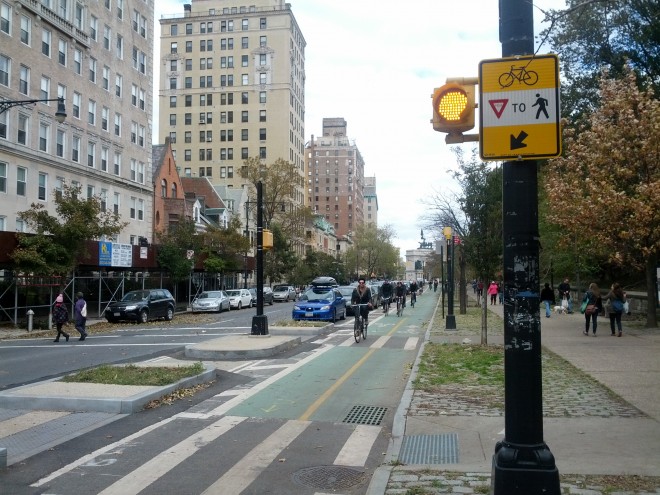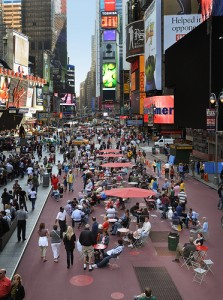A biweekly newsletter with public space news, resources, and opportunities.
A curated dispatch on all things public markets plus the latest announcements from the Market Cities Program.
Rightsizing may be completely redesigning a street with new infrastructure like lights, drainage, and complicated crossings, or is sometimes as simple as restriping the road to add a bike lane or change the parking. Common street rightsizing strategies follow.

The space of a lane formerly used for moving vehicles can be used for a variety of new purposes – a bike lane, expanded sidewalk space, or a median to help make it safer and easier for people to cross the street. Lane conversions also make the road safer, as the reduction from two lanes to one lane in a given direction minimizes lane changes and reduces speeding, because cars driving at an appropriate speed are more likely to set the pace of traffic.
A dual or two-way left turn lane gives drivers dedicated space to make left turns by creating a center lane exclusively for drivers making left turns. Two-way left turn lanes often replace what were two vehicle lanes (one in each direction) that could be used by both through traffic and left turning traffic. By separating left-turning vehicles from through traffic, these lanes can decrease accidents while counter-intuitively maintaining traffic volumes and point-to-point times, because the vehicle movements in each lane are more predictable and through traffic doesn't need to switch lanes to get around left-turning vehicles. Left hand turns are also better anticipated by cars coming in the other direction. This thorough 2006 report by the Minnesota Department of Transportation empirically confirms the positive safety effects of two-way left turn lanes, as does this FHWA analysis.
Bike lanes encourage biking, and can improve safety. Bike infrastructure ranges from lanes that are physically separated from motorized traffic by parking or other barriers, to simple ‘sharrow’ markings painted on the street. The most common bike lanes on rightsizing projects are painted lanes on the edge of the road. Research and surveys indicate that bike lanes are desired by bicyclists, encourage more biking, and facilitate safer biking.

Many rightsizing projects narrow driving lanes. Research shows that narrower lanes reduce motor vehicle speeding, and the extra space recovered by narrowing lanes can be used for other purposes, such as additional sidewalk space, bike lanes, or a median.
Some projects reduce the number of driving lanes, but increase the width of the remaining lanes in order to create room for vehicles to pass in case of bus stops or double parking, or to make room for people bicycling.

Rightsizing may include adding sidewalks to streets that lack them, increasing sidewalk widths, or improving their general appeal with new materials, landscaping, or lighting. Improving pedestrian infrastructure encourages walking, and can help generate room for other activities and infrastructure that encourage a sense of place.

Neckdowns are extensions of the curb that increase pedestrian space and shorten street crossings. They are common at pedestrian crossings, both at intersections and midblock. They protect pedestrians by slowing traffic, especially as drivers make turns, as well as by increasing pedestrians' visibility to drivers and reducing their intersection crossing distances. Neckdowns make it easier and safer for slower pedestrians, like small children and the elderly, to cross the street. Neckdowns are also known as curb extensions and bulbouts. They are often part of a more comprehensive set of strategies to improve street safety and expand space for pedestrians.

Pedestrian islands are places for pedestrians to stop while crossing the street. They are often located in the median of the street or sometimes between a bike lane and vehicular lane. They increase pedestrian safety and visibility much like a neckdown, by reducing the distance that a pedestrian has to cross through moving traffic, and by allowing a slow-moving pedestrian to split up a crossing in segments. They have been shown to reduce pedestrian injuries at intersections by about 40%. Rightsizing projects may install new pedestrian islands or medians, or expand the width or length of existing ones.
A median is a space between opposing travel lanes in the middle of a road. It can be hard infrastructure raised from the street and sometimes landscaped, or it can simply be marked space in the road that separates traffic beyond a double yellow line. Sometimes a median goes from crosswalk to crosswalk, splitting the street the whole way. Other times, the median ends some distance from the intersection to give vehicles a place to wait to turn left without delaying the vehicles that are going straight through the intersection. Medians in the center of the block can eliminate midblock turns across traffic as drivers attempt to enter driveways on the other side of the road. Both pedestrian islands and medians are associated with a range of safety benefits.

On streets with relatively long distances between intersections, it is sometimes important to add a midblock pedestrian crossing to improve safety for pedestrians. The crossing provides easy access between pedestrian attractions on either side of a street like bus stops, parks, schools, and retail. Midblock crossings can be regulated with crosswalks, yield/stop signs, and traffic signals, depending on the number of pedestrians and vehicles intersecting. A midblock crossing is safer with a pedestrian refuge island, particularly if the street has two-way traffic.
Crosswalks can be made more visible and aesthetically appealing with high visibility paint and designs, or materials like bright stone work or asphalt printings. On Nebraska Avenue these intersection treatments contributed to a 61% decline in pedestrian injuries.

Some streets have counterproductive or underutilized lanes for vehicular traffic, or have more parking than is necessary. There are often more beneficial uses for this public space. In many cities with large numbers of pedestrians and office workers, business improvement districts have worked with local government to convert this type of space into plazas. Times Square is a prominent example.
Roundabouts are circular intersections that are installed in place of stop signs or traffic signals. They allow traffic to safely maneuver through the intersection without coming to a complete stop or waiting for a red light. Research has shown that roundabouts can improve safety and mobility for all users, often at a lower cost than traffic signals. According to the Federal Highway Administration, roundabouts reduce crashes by 35%, injury crashes by 76%, and fatal crashes by 90 – 100%, compared to previous configurations. Roundabouts often reduce congestion during rush hours, as they allow continuous flow, and can provide other benefits, such as an opportunity for landscaping. Roundabouts often cost about the same as traffic signals for installation, however they have much lower long-term maintenance costs. However, each intersection should be separately examined to ensure that the roundabout will function well.

Lane directions can be reconfigured to support rightsizing goals, by changing a two-way street to a one-way street, or a one-way to a two-way street. Converting a two-way to a one-way street can free space, either by eliminating a lane or simply because less street width is needed for two lanes going in the same direction. Conversely, converting from a one-way to a two-way street can be an effective traffic calming measure, slowing traffic by reducing lane widths and demanding that drivers exercise caution.
Landscaping, such as trees and other plants, can make the street more appealing for all users, and can be used in tandem with other treatments, like medians or neckdowns, to break up concrete's monotony, attract pedestrians, raise real estate values, and ease burdens on drainage systems by diverting storm water. Street trees in particular have a host of potential benefits, including traffic calming.
In areas without driveways where lanes have been eliminated, it may be helpful to the adjacent businesses and residents to have drop-off designated curb space in the parking lane for some or all of the day to mitigate the potential disruption and ticketing of double-parked vehicles. This measure was used on Prospect Park West in response to local concerns.
Many streets that are rightsized are active bus routes. Especially where there is only one dedicated moving lane, it is important to create a space exclusively for buses at bus stops so that they do not negatively impact other traffic when they stop to pick up passengers and to ensure they are able to quickly load and unload. Where there are two moving lanes in a given direction, the lane closer to the curb in the vicinity of the stop can be made exclusive to buses as a turnout. A bus turnout can also be located in place of parking. Alternately, a bus bulb can extend the sidewalk to the moving lane to speed boarding, also minimizing delays at bus stops.
As an integral part of the street, parking reconfiguration can be part of rightsizing. In places where lane or lane width reductions free up street space, parallel parking can be converted to diagonal parking, thus increasing the number of parking spots. Bridgeport, a small community in the California mountains, recently implemented this treatment to encourage passing drivers to stop on their main street and to improve safety for residents. Parking can also be used to protect bicycle lanes, as in Prospect Park West in Brooklyn. In other projects, some parking may be removed to improve intersection safety or to create space for other improvements. For instance, if a road is reduced from two lanes to one lane in one direction, the corner parking spot may need to be removed to maintain safe turning movements for fire trucks and other large vehicles. Another change is to convert an entire parking lane into pedestrian or bicycle infrastructure, where the conditions call for it, such as with The Porch at 30th Street Station in Philadelphia.

The rich text element allows you to create and format headings, paragraphs, blockquotes, images, and video all in one place instead of having to add and format them individually. Just double-click and easily create content.
The rich text element allows you to create and format headings, paragraphs, blockquotes, images, and video all in one place instead of having to add and format them individually. Just double-click and easily create content.
Body Text Body Link
The rich text element allows you to create and format headings, paragraphs, blockquotes, images, and video all in one place instead of having to add and format them individually. Just double-click and easily create content.
Here is some highlighted text from the article.




Headings, paragraphs, blockquotes, figures, images, and figure captions can all be styled after a class is added to the rich text element using the "When inside of" nested selector system.
Headings, paragraphs, blockquotes, figures, images, and figure captions can all be styled after a class is added to the rich text element using the "When inside of" nested selector system.
Headings, paragraphs, blockquotes, figures, images, and figure captions can all be styled after a class is added to the rich text element using the "When inside of" nested selector system.

We are committed to access to quality content that advances the placemaking cause—and your support makes that possible. If this article informed, inspired, or helped you, please consider making a quick donation. Every contribution helps!
Project for Public Spaces is a 501(c)(3) tax-exempt organization and your donation is tax-deductible within the guidelines of U.S. law.